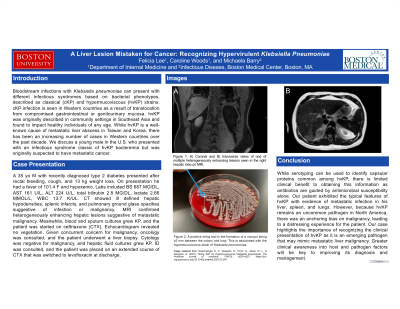Monday Poster Session
Category: Liver
P3885 - A Liver Lesion Mistaken for Cancer: Recognizing Hypervirulent Klebsiella pneumoniae
Monday, October 27, 2025
10:30 AM - 4:00 PM PDT
Location: Exhibit Hall

Has Audio
- FL
Felicia Lee, MD
Boston Medical Center
Boston, MA
Presenting Author(s)
Felicia Lee, MD, Caroline Woods, MD, Michaela Barry, MD
Boston Medical Center, Boston, MA
Introduction: Bloodstream infections with Klebsiella pneumoniae can present differently depending on the bacterial phenotype, which have been described as classical (cKP) and hypermucoviscous (hvKP) strains. cKP infection is seen in Western countries as a result of translocation from compromised gastrointestinal or genitourinary mucosa. hvKP was originally described in community settings in Southeast Asia and found to impact healthy individuals of any age. While hvKP is a well known cause of metastatic liver abscess in Taiwan and Korea, an increasing number of cases have been reported in Western countries over the past decade. We discuss a young male in the U.S. who presented with an infectious syndrome classic of hvKP bacteremia, but was originally suspected to have metastatic cancer.
Case Description/Methods: A 35 yo M with recently diagnosed type 2 diabetes presented after rectal bleeding, cough, and 13 kg weight loss. On presentation he had a fever of 101.4 F and was hypoxemic. Labs included BS 687 MG/DL, AST 161 U/L, ALT 224 U/L, total bilirubin 2.8 MG/DL, lactate 2.66 MMOL/L, WBC 13.7 K/UL. CT showed ill defined hepatic hypodensities, splenic infarcts, and pulmonary ground glass opacities suggestive of infection or malignancy. MRI confirmed heterogeneously enhancing hepatic lesions concerning for malignancy. Meanwhile, blood and sputum cultures grew KP, and the patient was started on ceftriaxone (CTX). Echocardiogram revealed no vegetation. Given concurrent concern for malignancy, oncology was consulted, and the patient underwent a liver biopsy. Cytology was negative for malignancy, and hepatic fluid cultures grew KP. ID was consulted, and the patient was placed on an extended course of CTX that was switched to levofloxacin at discharge.
Discussion: While serotyping can be used to identify capsular proteins common among hvKP, there is limited clinical benefit to obtaining this information as antibiotics are guided by antimicrobial susceptibility alone. Our patient exhibited the typical features of hvKP with evidence of metastatic infection in his liver, spleen, and lungs. However, because hvKP remains an uncommon pathogen in North America, there was an anchoring bias on malignancy, leading to a distressing experience for the patient. Our case highlights the importance of recognizing the clinical presentation of hvKP as it is an emerging pathogen that may mimic metastatic liver malignancy. Greater clinical awareness into host and pathogen factors will be key to improving its diagnosis and management.
Disclosures:
Felicia Lee, MD, Caroline Woods, MD, Michaela Barry, MD. P3885 - A Liver Lesion Mistaken for Cancer: Recognizing Hypervirulent <i>Klebsiella pneumoniae</i>, ACG 2025 Annual Scientific Meeting Abstracts. Phoenix, AZ: American College of Gastroenterology.
Boston Medical Center, Boston, MA
Introduction: Bloodstream infections with Klebsiella pneumoniae can present differently depending on the bacterial phenotype, which have been described as classical (cKP) and hypermucoviscous (hvKP) strains. cKP infection is seen in Western countries as a result of translocation from compromised gastrointestinal or genitourinary mucosa. hvKP was originally described in community settings in Southeast Asia and found to impact healthy individuals of any age. While hvKP is a well known cause of metastatic liver abscess in Taiwan and Korea, an increasing number of cases have been reported in Western countries over the past decade. We discuss a young male in the U.S. who presented with an infectious syndrome classic of hvKP bacteremia, but was originally suspected to have metastatic cancer.
Case Description/Methods: A 35 yo M with recently diagnosed type 2 diabetes presented after rectal bleeding, cough, and 13 kg weight loss. On presentation he had a fever of 101.4 F and was hypoxemic. Labs included BS 687 MG/DL, AST 161 U/L, ALT 224 U/L, total bilirubin 2.8 MG/DL, lactate 2.66 MMOL/L, WBC 13.7 K/UL. CT showed ill defined hepatic hypodensities, splenic infarcts, and pulmonary ground glass opacities suggestive of infection or malignancy. MRI confirmed heterogeneously enhancing hepatic lesions concerning for malignancy. Meanwhile, blood and sputum cultures grew KP, and the patient was started on ceftriaxone (CTX). Echocardiogram revealed no vegetation. Given concurrent concern for malignancy, oncology was consulted, and the patient underwent a liver biopsy. Cytology was negative for malignancy, and hepatic fluid cultures grew KP. ID was consulted, and the patient was placed on an extended course of CTX that was switched to levofloxacin at discharge.
Discussion: While serotyping can be used to identify capsular proteins common among hvKP, there is limited clinical benefit to obtaining this information as antibiotics are guided by antimicrobial susceptibility alone. Our patient exhibited the typical features of hvKP with evidence of metastatic infection in his liver, spleen, and lungs. However, because hvKP remains an uncommon pathogen in North America, there was an anchoring bias on malignancy, leading to a distressing experience for the patient. Our case highlights the importance of recognizing the clinical presentation of hvKP as it is an emerging pathogen that may mimic metastatic liver malignancy. Greater clinical awareness into host and pathogen factors will be key to improving its diagnosis and management.
Disclosures:
Felicia Lee indicated no relevant financial relationships.
Caroline Woods indicated no relevant financial relationships.
Michaela Barry indicated no relevant financial relationships.
Felicia Lee, MD, Caroline Woods, MD, Michaela Barry, MD. P3885 - A Liver Lesion Mistaken for Cancer: Recognizing Hypervirulent <i>Klebsiella pneumoniae</i>, ACG 2025 Annual Scientific Meeting Abstracts. Phoenix, AZ: American College of Gastroenterology.
